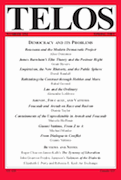David Randall’s “Empiricism, the New Rhetoric, and the Public Sphere” appears in Telos 154 (Spring 2011). Read the full version at TELOS Online website.
 Jürgen Habermas’s conception of the early modern public sphere derived in good part from a Kantian epistemology and the corollary Kantian theory of communication. Yet we can, and should, instead conceive of the public sphere as rhetorical in nature, and therefore substitute a rhetorical epistemology and theory of communication for the Kantian equivalents that underpin Habermas’s account. But if rhetoric is to be substituted for Kantian reason in an account of the early modern public sphere, one must argue the existence of an intellectual tradition of rhetorical philosophy concurrent with and parallel to that of Habermas’s Kantian tradition, and equally able to claim itself both representative of the thought of the age and indicative of the thought and practice of the multitude. This historically situated rhetorical philosophy did exist. The empirical tradition itself, from Locke through Hume, preserved an astonishing amount of rhetorical thought. Secondly, the tradition of New Rhetoric, as exemplified by figures such as Adam Smith, George Campbell, and Hugh Blair, reconceived rhetoric around empirical epistemology. The intellectual tradition that leads from Locke, through Hume, to George Campbell has as much claim as the Kantian tradition to articulate, and represent, the practice of the early modern public sphere.
Jürgen Habermas’s conception of the early modern public sphere derived in good part from a Kantian epistemology and the corollary Kantian theory of communication. Yet we can, and should, instead conceive of the public sphere as rhetorical in nature, and therefore substitute a rhetorical epistemology and theory of communication for the Kantian equivalents that underpin Habermas’s account. But if rhetoric is to be substituted for Kantian reason in an account of the early modern public sphere, one must argue the existence of an intellectual tradition of rhetorical philosophy concurrent with and parallel to that of Habermas’s Kantian tradition, and equally able to claim itself both representative of the thought of the age and indicative of the thought and practice of the multitude. This historically situated rhetorical philosophy did exist. The empirical tradition itself, from Locke through Hume, preserved an astonishing amount of rhetorical thought. Secondly, the tradition of New Rhetoric, as exemplified by figures such as Adam Smith, George Campbell, and Hugh Blair, reconceived rhetoric around empirical epistemology. The intellectual tradition that leads from Locke, through Hume, to George Campbell has as much claim as the Kantian tradition to articulate, and represent, the practice of the early modern public sphere.







